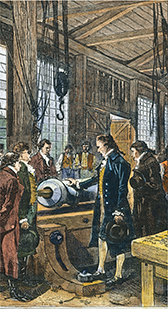16.1 Thermal Energy and Matter
Reading Focus
 Key Concepts
Key Concepts
 In what direction does heat flow spontaneously?
In what direction does heat flow spontaneously? What is the temperature of an object related to?
What is the temperature of an object related to? What two variables is thermal energy related to?
What two variables is thermal energy related to? What causes thermal expansion?
What causes thermal expansion? How is a change in temperature related to specific heat?
How is a change in temperature related to specific heat? On what principle does a calorimeter operate?
On what principle does a calorimeter operate?
Vocabulary
heat
temperature
absolute zero
thermal expansion
specific heat
calorimeter
Reading Strategy
Previewing Copy the table below. Before you read, preview the figures in this section and add two more questions to the table. As you read, write answers to your questions.
| Questions About Thermal Energy and Matter | Answers |
|---|---|
Which has more thermal energy, a cup of tea or a pitcher of juice? |
a. |
b. |
c. |
d. |
e. |

Figure 1 Count Rumford supervised the drilling of brass cannons in a factory in Bavaria. From his observations, Rumford concluded that heat is not a form of matter.
In the 1700s, most scientists thought heat was a fluid called caloric that flowed between objects. In 1798, the American-born scientist Benjamin Thompson (1753–1814), also known as Count Rumford, challenged this concept of heat. Rumford managed a factory that made cannons. Figure 1 shows how a brass cylinder was drilled to make the cannon barrel. Water was used to cool the brass so that it did not melt. Rumford observed that the brass became hot as long as the drilling continued, producing enough heat to boil the water. Soon after the drilling stopped, however, the water stopped boiling. When the drilling resumed, the water again came to a boil. Based on his observations, Rumford concluded that heat could not be a kind of matter, but instead was related to the motion of the drill.
Work and Heat
A drill is a machine that does work on the cannon. Remember that no machine is 100 percent efficient. Some of the work done by the drill does useful work, but some energy is lost due to friction. Friction causes the moving parts to heat up. The more work done by the drill, the more that friction causes the cannon to heat up.
Heat is the transfer of thermal energy from one object to another because of a temperature difference.  Heat flows spontaneously from hot objects to cold objects. Heat flows from the cannon to the water because the cannon is at a higher temperature than the water.
Heat flows spontaneously from hot objects to cold objects. Heat flows from the cannon to the water because the cannon is at a higher temperature than the water.





